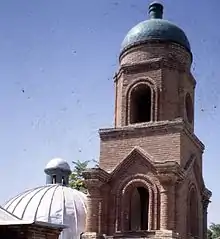Russians in Iran
Iranian Russians are Russians living in Iran or Iranians of Russian descent. Russians populate various regions, but mostly in those regions which had been under direct Russian military occupation in the past, thus in Russia's sphere of influence. This was an indirect result of the outcome of the last Russo-Persian Wars.[1] Nowadays there are Russians located in the southern regions of the country as well (such as Bushehr), where many of them work as technicians and nuclear experts, on for example the Bushehr Nuclear Power Plant.
| |||||
| Regions with significant populations | |||||
|---|---|---|---|---|---|
| Tehran, Mazandaran Province, Gilan Province, Bushehr, Iranian Azerbaijan | |||||
| Languages | |||||
| Russian, Persian | |||||
| Religion | |||||
| Russian Orthodox Church, Shia Islam | |||||
Although the community has shrunk significantly since the Second World War, the following Iran crisis of 1946 and the Iranian Revolution, Russians are known to be living in Iran since the time of the Safavids.[2]
History
Russians in Iran (Persia) have a long history dating back many centuries.[3][4] However, the first mass-immigration of Russians into Iran occurred in the early 20th century when hundreds of thousands of White émigrés had to flee from the Bolsheviks. Most of them landed in the north Iranian provinces of Gilan and Mazandaran, but also in the northwest and northeast, in Iranian Azerbaijan and Khorasan, where communities of their descendants still live.[5][6]
The Russian community kept increasing in the northern provinces of the country, as a result of the Russian sphere of influence which was established since the Russo-Persian War of 1826-28.[7] This influence ended some decades later with the crisis of 1946.
Russian Orthodoxy
The once numerous Russian Orthodox community in Iran has shrunken over the years. They are mostly the descendants of Russian émigrés and the permanently accredited staff of diplomatic and trade missions.
Tehran's Orthodox Community traces its history to the late 16th century.
St. Nicholas Church, Tehran was built the 1940s on donations from Russian émigrés. It was designed by émigré architect and Iranian Army officer Nikolai Makarov. As soon as the crosses appeared on its cupolas, the half-finished church opened its doors to parishioners. There were several Orthodox priests in Tehran before the 1979 Islamic Revolution. In the early 1980s, all of them were expelled. It was not until the late 1990s that the St. Nicholas Church received its new head priest. Hieromonk Alexander Zarkeshev was appointed by the Moscow Patriarchate to serve in Tehran.[8]
See also
- Russian diaspora
- White émigré
- Russian Ecclesiastical Mission in Urmia
- St. Nicholas Church, Tehran
- Russian Church, Qazvin
- Urmia Orthodokseta
- Iran-Russia relations
- Russo-Persian Wars
- Iranians in Russia
- Anglo-Russian Convention of 1907
- 1908 bombardment of the Majlis
- Persian Campaign
- Persian Socialist Soviet Republic
- Anglo-Soviet invasion of Iran
- Iran crisis of 1946
- 1953 Iranian coup d'état
- Project Dark Gene
- Russians in post-Soviet states
References
- Russia and Iran, 1780-1828 U of Minnesota Press, 1 mei 1980 ISBN 978-0816656974 p 160
- "Russian Orthodoxy In Iran". Retrieved 5 April 2014.
- Russian travellers in Iran to 1917 - Iranicaonline
- Russia-Iran relations "RUSSIA i. Russo-Iranian Relations up to the Bolshevik Revolution"
- Rezun, Miron (January 1981). The Soviet Union and the Iran: Soviet Policy in Iran from the Beginnings of the Pahlavi Dynasty Until the Soviet Invasion in 1941. ISBN 9028626212. Retrieved 5 April 2014.
- Volodarskiĭ, Mikhail I.; Volodars (1994). The Soviet Union and Its Southern Neighbours: Iran and Afghanistan, 1917-1933. ISBN 9780714634852. Retrieved 5 April 2014.
- Poulson, Stephen C. (2006). Social Movements in Twentieth-century Iran: Culture, Ideology, and Mobilizing Frameworks. ISBN 9780739117576. Retrieved 5 April 2014.
- "Russian Orthodoxy In Iran". Retrieved 5 April 2014.
Further reading
- Atabaki, Touraj; Volkov, Denis V. (2020). "Flying away from the Bolshevik winter: Soviet refugees across the Southern borders (1917–30)". Journal of Refugee Studies. Oxford University Press. doi:10.1093/jrs/fez122.



